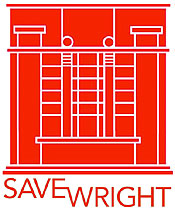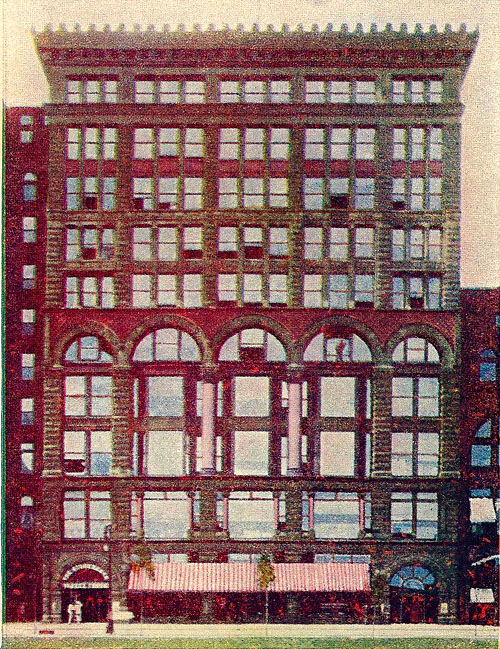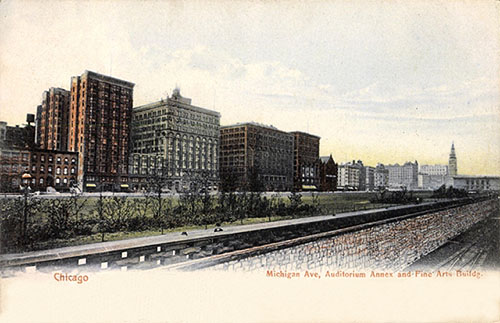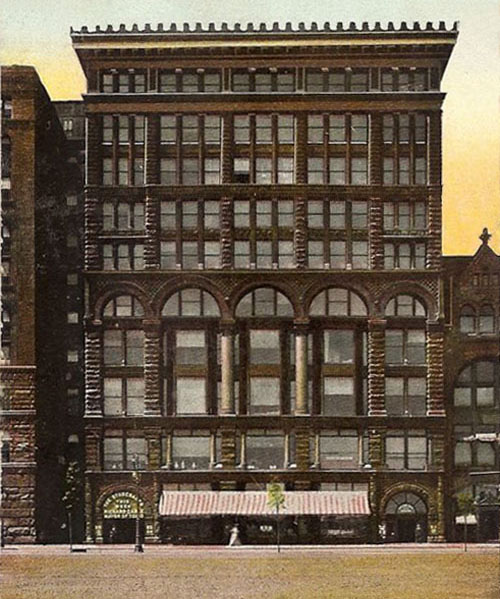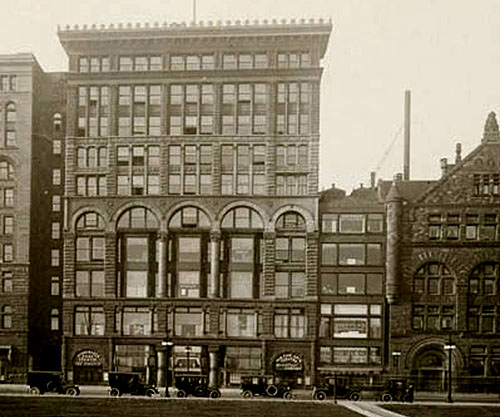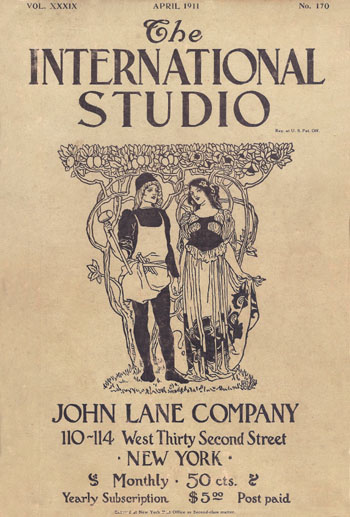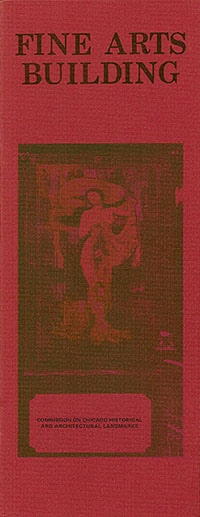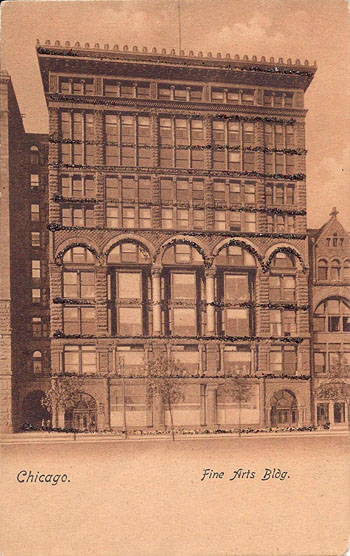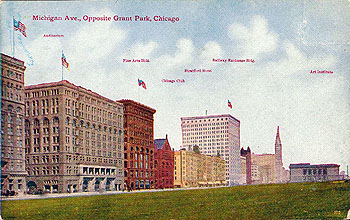
SUPPORT
THE WRIGHT LIBRARYPROCEEDS FROM EVERY SALE GOES TO SUPPORT THE WRIGHT LIBRARY.
CLICK TO ORDER.
WE PROUDLY SUPPORT THE FRANK LLOYD WRIGHT BUILDING CONSERVANCY
WE PROUDLY SUPPORT FALLINGWATER
AND THE WESTERN PENNSYLVANIA CONSERVANCY
WRIGHT STUDY
Browne's Bookstore, Chicago (1907 - S.141)
Fine Arts Building Books & Publications Photographs Postcards
Located adjacent to the Auditorium Building on Michigan Avenue, the Fine Arts Building was originally The Studebaker Building, a carriage factory and showroom. It was constructed as an eight story building in 1885 and designed by architect Solon S. Beman. Needing additional space in the early 1890s, they demolished the smaller adjacent three story building, and constructed the five story attached annex. The annex was remodeled by 1909 when Wright designed the Thurber Art Galleries and remains consistent today. Adjacent to the annex was the original Art Institute of Chicago, constructed in 1886-87 by Burnhan and Root. In 1892 when the Art Institute move across the street to the present location in Grant Park, the Chicago Club occupied the building.
By 1895, the annex proved insufficient, and in 1896 they moved to a larger facility. The Studebakers decided to convert the building into studios and theaters to be an artistic and literary center. They turned to Berman again, and the renovated ten story building opened in the summer of 1898. It soon became a hub for writers, artists, musicians, publishers, galleries, societies and Wright himself, from 1908 through 1910. It became known as "the first art colony in Chicago". Wright's interest in publishing and Japanese prints lead him to become a member of The Caxton Club which was located on the tenth floor of the building. Both Francis Fisher Browne and Wright were members. Wright's interest in publishing limited edition books went back to 1896 with hisinvolvement in "The Eve of St. Agnes" and "The House Beautiful" 1896-1898. Another member of the Caxton Club was publisher Ralph Fletcher Seymour who located his publishing company in The Fine Arts Building. In 1911, he published "The Morality of Women" for Wright and Mamah Bouton Borthwick (Cheney) as well as two other volumes. In 1912 Seymour published Wright's first edition of "The Japanese Print".
Another tenant in the Fine Arts Building was The Arts Club of Chicago. Wright held an Exhibition there of Japanese Prints entitled "Antique Colour Prints From The Collection of Frank Lloyd Wright" beginning November 12 and ending December 15, 1917.
"The Dial", a semi-monthly journal of Literary criticism, discussion and information, founded by Francis Fisher Brown also had offices in the Fine Building. Other tenants included: The Municipal Arts League, the Public School arts Society, the Daughters of the American Revolution, the Women's Suffrage Movement, sculpture Lorado Taft, publisher Ralph Fletcher Seymour, the Chicago offices of The Saturday Evening Post, and The Little Review, to name just a few.
Wright's first project in the Fine Arts Building was a bookstore on the seventh floor for Francis Fisher Brown, (1907 - S.141). Wright's second and third projects were the Thurber Art Galleries (1909 - S.154) which occupied the entire fifth floor of the Annex, and the Mori Oriental Art Studio (1914 - S. 181) on the eighth floor.
1: Studebaker Building circa 1886-87. A carriage factory and showroom, it was constructed as an eight story building in 1885 and designed by architect Solon S. Beman. Needing additional space in the early 1890s, they demolished the smaller adjacent three story building, and constructed the five story attached annex. The annex was remodeled by 1909 when Wright designed the Thurber Art Galleries and remains consistent today. Adjacent to the annex (right) was the original Art Institute of Chicago, constructed in 1886-87 by Burnhan and Root. In 1892 when the Art Institute move across the street to the present location in Grant Park, the Chicago Club occupied the building. Photograph Courtesy Cornell University Library. 2: Fine Arts Building Circa 1901-1902. Front: "Chicago. Fine Arts Bldg." On December 24, 1901, the U.S. Government allowed the use of the words "Post Card" or "Postcard" to be printed on the undivided back of privately printed cards. So this card would have been produced most likely in 1901. But the photograph would have been taken earlier. Photographs and Post cards dating between April 1901 through circa 1905 included a large awning on the first floor. This photograph most likely taken between 1897-1900. Image is printed in a tinted "Collotype" process. The front image is enhanced with glitter. Back: "Post Card. Koelling & Klappenbach, Publishers Chicago, Ill. No. 233. Printed in Germany. This side (of post card) is for the address." Postmark December 6, 1905. K&K published post cards during the 1880s through 1906. They published post cards in tinted Collotype in Germany. Int3 3a: Fine Arts Building April 1901. The reader board above the door on the left reads "The Studebaker, Castle Square Opera Co. Pirates of Penzance". The May 1, 1901 issue of "The Dial" ran an ad, "The Studebaker. Fine Arts Building... 3D Year. Castle Square Opera Company. Week of April 29 - Pirates of Penzance." The "Pirates of Penzance" was performed two times. Construction began in late 1887 on the Auditorium building (left) and in late 1889 it held its grand opening. 3b: Fine Arts Building April 1901 detail. Browne's Bookstore, which opened for business during the last few months of 1907, was located on the left side of the seventh floor as you faced the building (center three windows in this photograph). 4: Fine Arts Building Circa 1902. The trees in the foreground are very similar to the 1901 photograph and look to be just a bit smaller in the 1903-04 postcard. There are no awnings on the Annex Building to the right in 1901, they are visible in 1903-4. The awnings are visible in this postcard. The printing is not clear enough to be able to read the reader board above the door on the left. 5: Fine Arts Building 1903-04. The reader board above the door on the left reads "The Studebaker, Yankee Consul". The December 16, 1903 issue of "The Dial" ran an ad, "The Studebaker. Fine Arts Building. Beginning Monday, December 14, Mr. Henry W. Savage Offers, Raymond Hitchcock. In the New Comic Opera Success, The Yankee Consul, By H, M. Blossom, Jr., and A. G. Robyn." "Yankee Consul was performed 56 times. Awing can be seen in front of first floor. Addition trees have been added in foreground. Original Annex is to the right of the Fine Arts Building. The annex was remodeled by 1909 when Wright designed the Thurber Art Galleries and remains consistent today. 6: Fine Arts Building Circa 1903-05. Early postcard postmarked 1905. Awing can be seen in front of first floor. Original Annex is to the right of the Fine Arts Building. The annex was remodeled by 1909 when Wright designed the Thurber Art Galleries and remains consistent today. 7: Fine Arts Building Circa 1903-05. Early postcard image postmarked 1907. Awing can be seen in front of first floor. Original Annex is to the right of the Fine Arts Building. The annex was remodeled by 1909 when Wright designed the Thurber Art Galleries and remains consistent today. 8: Fine Arts Building Circa 1907-08. Approximate time frame of the Browne's Bookstore. Early postcard image. Awing has been removed from the front of first floor. The verso of this postcard included a divided back. Postcards with a divided back were finally permitted on March 1, 1907. Original Annex is to the right of the Fine Arts Building. The annex was remodeled by 1909 when Wright designed the Thurber Art Galleries and remains consistent today. 9: Fine Arts Building and Annex Circa 1915. By this time, Browne's Bookstore had vacated the Wright designed space on the seventh floor. In September, 1911 they vacated the seventh floor for space on the first floor. In April 1912 the directors decided to close Browne's Bookstore. Original Annex is to the right of the Fine Arts Building. The annex was remodeled by 1909 when Wright designed the Thurber Art Galleries, which occupied the entire fifth (top) floor of the annex. The annex remains consistent today. Photographed by J. W. Taylor, Chicago, Circa 1915.
Books & Publications Date: 1901 Title: Kindergarten Magazine - March 1901 (Published by the Kindergarten Magazine Company, Fine Arts Building, Chicago)
Author: Anonymous
Description: "The Fine Arts Building, Chicago... This impressive building marks a unique step in business enterprise. As its name indicates, it is devoted to the exclusive use of the artist world. The idea of such an office building matured slowly in the mind of its present manager, Mr. C. C. Curtis, for fifteen years... Among the prominent social organizations that center here is the Chicago Women’s Club... Other literary and social clubs that find a home here are the Caxton, the Fortnightly, the Young Fortnightly, the Daughters of the American Revolution, and the Chicago Glee Club. Many artists whose names are familiar... Lorado Taft, Charles Francis Brown, Mari R. Hofer, Ralph Seymour... Among the literary and educational publishers are the following: Prang Educational Company... D. Appleton & Co., The Dial, Saturday Evening Post, Child Study Monthly..." Includes five photographs. (Digital and printed copy)
Size: 6 x 9.5
Pages: Pp 418-422
S#: 0049.13.0116
Date: 1908 Title: Musical Memories, My Recollections of Celebrities of the Half Century, 1850--1900 (Published by A. C. McClurg & Co., Chicago. Printed by The University Press, Cambridge, U.S.A.)
Author: Upton, George P.
Description: "The Studebaker Theatre... is but one feature of the Fine Arts Building... and is the accomplishment of Mr. Charles C. Curtiss. It is a hive of busy workers in music, painting, sculpture, literature, and the arts and crafts. Its various cells house the theatre, the music hall, the assembly hall, the Amateur Musical Club, the Fortnightly Club, the Caxton Club, ‘The Dial,’ the only high-class literary periodical in the country... The Studebaker Theatre was dedicated September 29, 1895, as the Studebaker Hall, and was opened as a theatre in the first week of April, 1899, by the Castle Square Opera Company... Since 1899 (through October 1908), eighty-eight different works of a musical character have been performed in the theatre, besides a large number of dramas and many concerts... The light operas include...Pirates of Penzance, 2 (performances)... Yankee Consul, 56..." Digital and printed version. 5.5 x 8.3. For more information see our Wright Study on Browne’s Bookstore.
Pages: Pp 345
0085.08.0311
Date: April 1911 Publication: The International Studio - (Published Monthly by the John Lane Company, New York)
Author: Peattie, Elia W.
Description: "The fine Arts Building in Chicago. The Fine Arts Building in Chicago is remarkable among such enterprises as housing within its walls so great a proportion of the artistic, intellectual literary and educational interests of a great city. The building is occupied by sculptors, painters, actors, musicians, writers, illustrators, etchers, gold and silversmiths, carvers, decorators, publishers of special editions, teachers of elocution and expression, the drama and the cognate arts... In short, the Fine Arts Building... does not so much borrow importance from that fact as lend importance to it." Includes five photographs, one of which is of the Thurber Art Galleries (1909 - S.154). This article was republished in a book form entitled "The Book of the Fine arts Building", 1911. Digital edition. Original cover price 50c. 8 x 11.5. (For additional information see our Study of the Browne's Bookstore.)
Pages: Pp XLIV-XLVI
0104.08.0211
Date: 1977 Title: Fine Arts Building (Soft Cover) (Published by the Commission on Chicago Historical and Architectural Landmarks, Chicago)
Author: Pomaranc, Joan
Description: Fine Arts Building, Solon S. Beman, Architect. Constructed in 1885, Converted to Fine Arts Building in 1898. "The Five Studebaker brothers began manufacturing carriages and wagons in South Bend, Indiana in 1852... The Studebakers decided to retain ownership of the older building and it into studios and theaters. They were persuaded to undertake such a project by Charles C. Cuttiss who became the buildings manager under its new name, the Fine Arts Building." It became known as "the first art colony in Chicago". Wright's first project in the Fine Arts Building was a bookstore on the seventh floor for Francis Fisher Brown, (1907 - S.141). Wright's second and third projects were the Thurber Art Galleries (1909 - S.154) which occupied the entire fifth floor of the Annex, and the Mori Oriental Art Studio (1914 - S. 181) on the eighth floor. Includes eleven photographs of the Fine Arts Building, but none of Wright’s three projects. 4.75 x 10.75 (First Edition) (For additional information see our Wright Study of the Browne's Bookstore.)
Pages: Pp 12
2033.03.0211
Date: 2008 (1911) Title: The Book of the Fine Arts Building, A Facsimile Edition of the Original Monograph (Soft Cover) (Originally published in 1911 for the Corporation of the Fine Arts Building by Ralph Fletcher Seymour Co., Chicago. 1000 copies were printed on paper, 25 copies on Imperial Japan Vellum. This facsimile edition published by The Hyoogen Press, Inc., Chicago)
Author: Peattie, Elia W.; Edited by Swan, David
Description: "Foreward (1911). The recent publication in ‘The International Studio,’ the foremost art publication in America, of the article on the Fine Arts building which is reproduced in the following pages, as well as the numerous printed commendations which had from time to time since the inception of the enterprise shown an extended and continued public interest in the building... The Fine Arts Building, including within its walls, as it does, the most important of the artist, musical, educational and literary interests of the city..." Includes an interior and exterior photograph of the second Browne’s Bookstore on the first floor, as well as two photographs of the Thurber Art Galleries, the entrance and interior. Original list price $20.00. 8.5 x 11.75. (For additional information see our Wright Study of the Browne's Bookstore.)
Pages: Pp 37
S#: 2008.08.0111
Postcards Date: C 1901-02 Title: Fine Arts Building Circa 1901-02.
Description: Front: "Chicago. Fine Arts Bldg." On December 24, 1901, the U.S. Government allowed the use of the words "Post Card" or "Postcard" to be printed on the undivided back of privately printed cards. So this card would have been produced most likely in 1901. But the photograph would have been taken earlier. Photographs and Post cards dating between April 1901 through circa 1905 included a large awning on the first floor. This photograph most likely taken between 1897-1900. Image is printed in a tinted "Collotype" process. The front image is enhanced with glitter. Back: "Post Card. Koelling & Klappenbach, Publishers Chicago, Ill. No. 233. Printed in Germany. This side (of post card) is for the address." Postmark December 6, 1905. K&K published post cards during the 1880s through 1906. They published post cards in tinted Collotype in Germany.
Size:
S#: 0048.03.0312
Date: Circa 1902 Title: Fine Arts Building Circa 1902. Front: "5483.
Description: Fine Arts Building Chicago." The trees in the foreground are very similar to the 1901 photograph and look to be just a bit smaller in the 1903-04 postcard. There are no awnings on the Annex Building to the right in 1901, they are visible in 1903-4. The awnings are visible in this postcard. The printing is not clear enough to be able to read the reader board above the door on the left. Frank Lloyd Wright designed three projects in the Fine Arts Building. Browne’s Bookstore (1907 - S.141), Thurber Art Galleries (1909 - S.154) and Mori Oriental Art Studio (1914 - S. 181).
Size: 3.5 x 5.5
S#: 0052.03.1211
Date: Circa 1907-08 Title: Fine Arts Building Circa 1907-08.
Description: Front: "Michigan Ave. Opposite Grant, Chicago. Auditorium. Fine Arts Bldg. Chicago Club. Stratford Hotel. Railway Exchange Bldg. Art Institute." Verso: "100. Michigan Ave. Opposite Grant, Chicago. This thoroughfare is one of the principle boulevards of the city, being a connecting link with the other numerous boulevards and parks. On this boulevard is located great Art Museum, Auditorium Hotel, and other magnificent structures. Grant Park at the present is in course of construction, but when completed will be one of the finest parks and pleasure grounds ion the world. In this park will also be located the magnificent Field’s Museum." Bottom Left: " ‘Women’s World’ Largest Circulation in the World - greatest reading value in the World. Send 25c for full year’s subscription and this set of 50 Post Cards, went free and postpaid at once." Frank Lloyd Wright designed three projects in the Fine Arts Building. Browne’s Bookstore (1907 - S.141), Thurber Art Galleries (1909 - S.154) and Mori Oriental Art Studio (1914 - S. 181).
Size: 5.5 x 3.5
S#: 0085.15.0811
Back to Browne's Bookstore Back to Thurber Art Galleries BACK TO TOP
